Today was a bit slower on the negotiations front, since both the APA and the COP are in informal consultations with the chairs, and attendance is limited for observer organizations. Looking forward to seeing the Earth Negotiations Bulletin updates from inside the closed meetings! (If you’re not familiar with the ENB, it is by far my favorite way to track the negotiations, as they have reporters that gain access to the closed meetings and write up daily briefings published each morning about the day before).
We were able to make the most of some interesting side events to dive deeper into some of the issues today. I attended one of particular interest on the outlook for the new market mechanism for the Paris Agreement – the Sustainable Development Mechanism. With the troubles we have had with the CDM (Clean Development Mechanism) under the Kyoto Protocol, it looks like the board of the SDM has their work cut out for them! Read on for our updates from the day:
Delfina:
Today was a busy day. It started at 10am in a side event on the challenges and prospects of indigenous people in accessing funds from the GCF. This was a great discussion and I was particularly proud and engaged by one of the panelists, Tarcila Rivera, a major Peruvian indigenous and human rights activist from Peru. Her intervention was on the importance of enhancing traditional knowledge systems for indigenous communities.
Following the panel, I got the chance to interview Pascal Girot, spokesperson from the AILAC Bloc. The interview touched on topics such as AILACs main negotiating topics as well as challenges the Bloc will face through out the COP. It was a great experience.
Following the interview with Mr. Girot, in the afternoon, I attended a very compelling panel on Peru’s NDCs and indigenous alternatives about Megadrivers, Redd+, MRV, Zero Net deforestation. Additionally, I participated in a side event lead by Former Peruvian Minister of the Environment, COP20 President and now current leader of the WWF Global Climate and Energy Practice. The Panel included high- level representatives of Sweden Ministry of the Environment as well as Supply Chain Director of the Carbon Disclosure Project. The panel gave insight details and proposition on the role of non-state actors in enhancing near-term ambition and promoting the implementation of the Paris Agreement. My day ended with an informative talk by Mr. Lorenzo Gavilli from the UN on sustainable industrialization and international transport under SDG9.
Jade: The second day of the COP was equally exciting and chaotic. I attended an informal consultation on agriculture issues during which countries and negotiations blocs presented their varying positions on ag. issues. It was fascinating to hear country delegates speak after reading so many written submissions from these countries. It was especially great to hear a representative from the US delegation intervene with comments that I had part in through providing background for with my client. I went to various side events and talked with speakers and fellow participants. I met a man who was an indigenous representative from Morocco. After we chatted, he kindly gave me a bracelet with the flag of the indigenous peoples of Morocco.
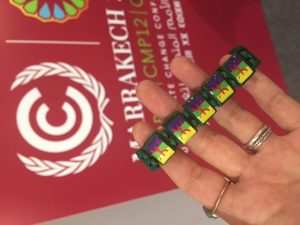
Megan: COP Day 2 was bit slow in terms of things happening. My first two engagements of the day, a meeting with my client and a promising event on global stock take, fell through, so my day really got rolling with an event at the US pavilion on Ocean Circulation and Climate. Even for someone studying marine resource management, it was very educational (not to mention that the US pavilion is super cool since NASA has decorated with moving world maps of all sorts looping through in the background). Next, I attended another ocean themed event focused on the role of marine ecosystem in nationally determined contributions before meeting up with Emily and a student delegation from Mexico interested in energy. It was great to meet other students and hear about their engagement at the conference and in these pressing climate issues that truly are global. Finally, I will be rounding the day out with a talk on the role of non-state actors and then another on equity, differentiation and ambition post-Paris.
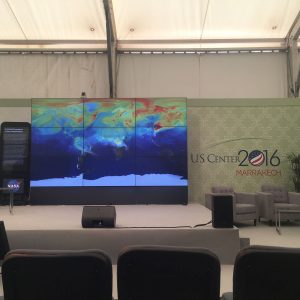
Tanya:
Seeing as I spent all my time in the blue (official) zone yesterday, I decided to explore the green zone of the COP this morning. Funnily, without the blue zone’s “translator headphones” I could not completely follow the event I attended which was titled “Water and climate in the French island territories”! So instead, I made my way through the Adaptation of African Agriculture initiative’s exhibition, also in the green zone. I particularly enjoyed how they used interactive technology to engage their audience, and bring problems, challenges and solutions to light – from holographic beneficiaries who talked to you about how AAA is helping them, and an interactive display room with all the information needed on issues relating to adaptation in agriculture, on soil, water, risk, financing, to hearing from government officials and researchers across the globe, via pre-recorded video, who have pledged their time, knowledge and energies to the initiative.
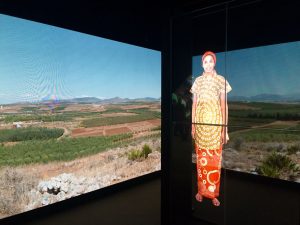
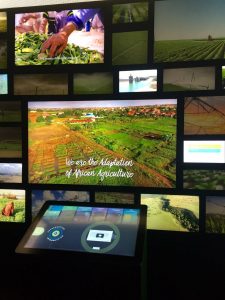
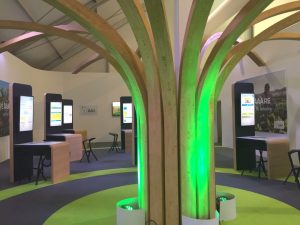
I spent the afternoon attending the Forest Day’s showcase event, where there were panels of government and regional leaders, researchers and scientists and civil society, including representatives of the indigenous peoples. The panels discussed the progress made on forests, how to engage public and private sectors, and how to unlock further financing.
In the early evening, I attended two events relating to adaptation – the first was on how to move forward with providing the most vulnerable communities access to climate risk insurance, and the second on the least developed countries expert group (LEG) work on supporting the LDCs on adaptation. At the first, several foundational pro-poor principles were discussed, and the difficult issues of affordability of premiums for vulnerable island states was raised (if not resolved). Several examples of success were provided – farmers’ insurance in Tanzania, and disaster/livelihoods insurance in St. Lucia, and I took these photos of the slides in question so I can follow up and learn a little more about how these policies work!
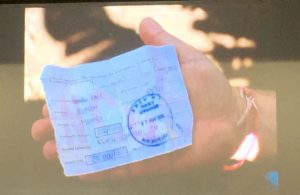
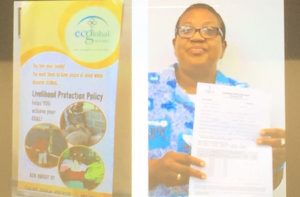
Finally, a provocative question without any real answers, rounded out the discussion on adaptation – how does a needs-based approach to climate insurance take into account those “needs” that cannot be quantified such as social cohesion and identity?